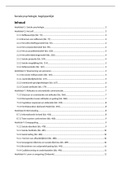Summary
Samenvatting Sociale psychologie, begrippenlijst
D.m.v. deze begrippenlijst een 8,2 gehaald! Bevat begrippen met betekenis uit de hoofdstukken 1,2,3,7,8,9 uit het boek Sociale psychologie - Roos Vonk. De begrippenlijst is geschreven voor het vak Sociale psychologie - Toegepaste psychologie op Fontys hogescholen Eindhoven.
[Show more]
Preview 2 out of 13 pages
Summarized whole book?
No
Which chapters are summarized?
Hoofdstuk 1,2,3,7,8,9
Uploaded on
August 16, 2021
Number of pages
13
Written in
2020/2021
Type
Summary
Book Title: Sociale Psychologie
Author(s): R. Vonk
Edition: juli 2017 ISBN: 9789089537850 Edition: 4
Institution
Fontys Hogeschool (Fontys)
Education
Toegepaste Psychologie
Course
Sociale Psychologie (TP1CSOPSY)
All documents for this subject (36)
By: lindseyjoosen • 2 year ago
$6.23
Also available in package deal from $24.95
100% satisfaction guarantee
Immediately available after payment
Both online and in PDF
No strings attached
Also available in package deal (1)
Theorievakken (5x) Toegepaste Psychologie - Fontys jaar 1, samenvattingen & begrippenlijsten
1. Summary - Inleiding in de psychologie, samenvatting & begrippenlijst
2. Summary - Persoonlijkheidsleer, samenvatting & begrippenlijst
3. Summary - Ontwikkelingspsychologie, samenvatting
4. Summary - Sociale psychologie, begrippenlijst
5. Summary - Spss, samenvatting
Show more
Sociale psychologie; begrippenlijst





